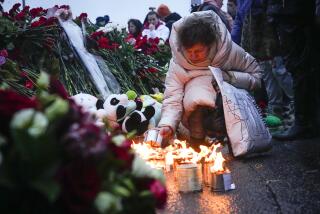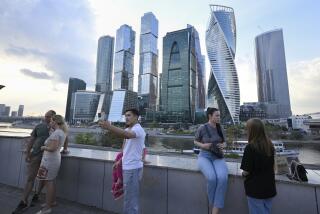Precarious Future for Cathedral in Moscow
- Share via
MOSCOW — It’s still one of the world’s great wonders, a riot of architectural panache and color that’s 4 1/2 centuries old and halts awed first-time viewers in their tracks.
But up close, St. Basil’s Cathedral is downright dilapidated, the Mir space station of churches. While cranes and repair crews in every direction signal the Moscow renaissance, Russia’s most recognizable landmark stands comparatively ignored on Red Square amid the boom.
The most glorious symbol of old Moscow is getting short shrift in the rush to construct malls, office towers, stadiums and especially the huge Christ the Savior Cathedral just upriver.
“Everyone loves us, everyone comes to us, but nobody needs us,” laments St. Basil’s chief curator, Lyubov Uspenskaya, whose pleas for public or private funds to fix the crumbling bricks and decrepit interior have fallen on deaf ears. “The state promises a lot, but what we actually receive is only a small percentage of that.”
Few would dispute that the cash-strapped Russian government should pay its pensioners, teachers and state workers first.
But authorities who manage to find or raise money for other renovation projects clearly view St. Basil’s as a low priority, perhaps because no one stands to get credit or profit from a costly restoration of those famous pineapple and onion domes.
Asked about the prospects for a fix-up, Culture Ministry spokeswoman Vera Lebedeva had a curt, no-nonsense reply: “Unfortunately, the government has no money [for St. Basil’s] and has no plans to fully restore it this year.”
The story of St. Basil’s is as familiar to Russians as the multicolored cupolas are to people worldwide through photographs, children’s books or as backdrops for TV newscasts from Moscow.
Ivan the Terrible had it built just outside the Kremlin walls in 1552 to honor Russia’s victory over the Tatars at Kazan. Formally named the Cathedral of the Intercession, it was nicknamed St. Basil’s after a holy man who was buried in the previous cathedral that stood on the site.
Living up to his own moniker, Ivan had the architects blinded so they could never build anything more beautiful, the legend goes.
Despite surviving decades of atheist rule and the wrecking balls that bashed in countless churches under Stalin, the cathedral’s bells have long been silent, and priests no longer preside at what is now a government museum.
Streams of tourists come to have photos snapped out front. But most don’t go in, dissuaded if not by the entrance fee (up to 26 rubles, or about $4.30), then by the less-than-welcoming appearance.
“It’s a beautiful masterpiece,” said Fazil Yoosuf, a visitor from Sri Lanka, gazing at the cathedral recently. “But it’s in pretty bad condition in some places. It’s clearly neglected.”
Under fading domes and scarred, crumbling bricks, the front entranceway, its white and red stripes faded almost beyond recognition, has the look of a bankrupt barbershop.
In the labyrinthine interior, where 10 small chapels lie under the cupolas, reconstruction work that officials say has been under way constantly since 1923 is proceeding at a glacial pace.
Glittering icons and bright wall paintings have been restored in some chapels. But, overall, the famous cathedral has the ambience of an old barn. The budget apparently doesn’t cover the heating bill, so museum employees must work bundled up against the winter chill.
The domes were last repainted when Moscow was host for the 1980 Summer Olympics. Officials say it’s well past time for St. Basil’s to have a true face lift: domes and gold-plating work repainted along with some frescoes and ornaments, basement rebuilt, runoff pipes and pavement redone.
And that’s just the outside. Uspenskaya estimates exterior renovation costs alone at $3 million. But sponsors can’t be found.
St. Basil’s neglect is in striking contrast to the nearby Christ the Savior Cathedral, a pet project of Moscow’s powerful mayor, Yuri Luzhkov.
Legions of workers have swarmed over that site for two years, and city authorities and the Russian Orthodox Church aggressively solicited donations via billboards, subway ads and TV commercials to help foot the reported $250 million tab.
“If not for the Cathedral of Christ the Savior, we would have been getting money,” Uspenskaya said.
Another problem, she noted with irony, is that St. Basil’s is not collapsing, which is the quickest way to get attention and money.
“We hope that sometime we’ll get what we need, maybe when the situation in the country becomes better,” the curator said. “Perhaps there are more urgent things to do now.”
More to Read
Sign up for Essential California
The most important California stories and recommendations in your inbox every morning.
You may occasionally receive promotional content from the Los Angeles Times.













